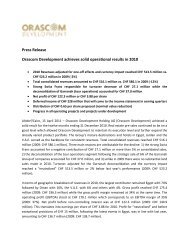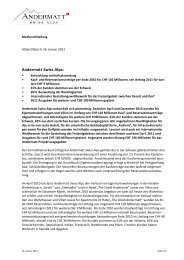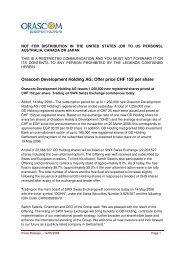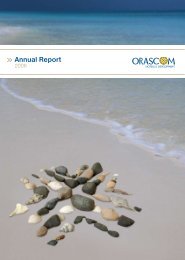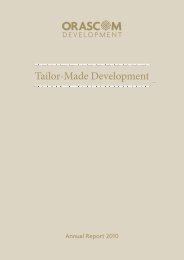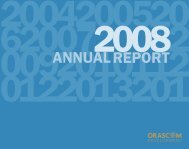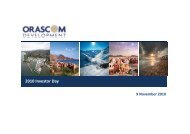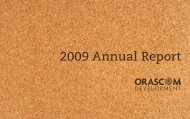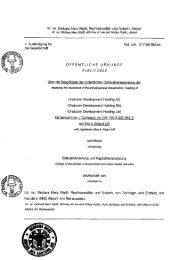FY 2012 Annual Report - Orascom Development
FY 2012 Annual Report - Orascom Development
FY 2012 Annual Report - Orascom Development
Create successful ePaper yourself
Turn your PDF publications into a flip-book with our unique Google optimized e-Paper software.
F-13 <strong>Orascom</strong> <strong>Development</strong> <strong>2012</strong> <strong>Annual</strong> <strong>Report</strong> F-14<br />
2.3 Standards and Interpretations in issue but not yet effective<br />
At the date of authorisation of these financial statements, the Group has not adopted the following Standards and Interpretations<br />
that have been issued but are not yet effective. They will be effective on or after the dates described below.<br />
New, amended and revised Standards and Interpretations<br />
IFRS 7/<br />
IAS 32<br />
IFRS 10<br />
IFRS 10<br />
IFRS 11<br />
IFRS 12<br />
IFRS 13<br />
The amendments to IAS 32 clarify existing application issues relating to the offset<br />
of financial assets and financial liabilities requirements. Specifically, the<br />
amendments clarify the meaning of ‘currently has a legally enforceable right of<br />
set-off’ and ‘simultaneous realisation and settlement’.<br />
The amendments to IFRS 7 require entities to disclose information about rights of<br />
offset and related arrangements (such as collateral posting requirements) for<br />
financial instruments under an enforceable master netting agreement or similar<br />
arrangement.<br />
IFRS 10 replaces the parts of IAS 27 Consolidated and Separate Financial<br />
Statements that deal with consolidated financial statements. SIC-12<br />
Consolidation – Special Purpose Entities has been withdrawn upon the issuance<br />
of IFRS 10. Under IFRS 10, there is only one basis for consolidation; that is<br />
control. In addition, IFRS 10 includes a new definition of control that contains<br />
three elements which should all be possessed by an entity to conclude it controls<br />
an investee, these are: (a) power over an investee, (b) exposure, or rights, to<br />
variable returns from its involvement with the investee, and (c) the ability to use<br />
its power over the investee to affect the amount of the investor's returns.<br />
The amendments to IFRS 10 introduce an exception to consolidating subsidiaries<br />
for an investment entity, except where the subsidiaries provide services that<br />
relate to the investment entity’s investment activities. Under the amendments to<br />
IFRS 10, an investment entity is required to measure its interests in subsidiaries at<br />
fair value through profit or loss. To qualify as an investment entity, certain criteria<br />
have to be met. Specifically, an entity is required to:<br />
- obtain funds from one or more investors for the purpose of providing<br />
them with professional investment management services;<br />
- commit to its investor(s) that its business purpose is to invest funds<br />
solely for returns from capital appreciation, investment income, or<br />
both; and<br />
- measure and evaluate performance of substantially all of its<br />
investments on a fair value basis.<br />
Consequential amendments to IFRS 12 and IAS 27 (as revised in 2011) have been<br />
made to introduce new disclosure requirements for investment entities.<br />
IFRS 11 replaces IAS 31 Interests in Joint Ventures. IFRS 11 deals with how a joint<br />
arrangement of which two or more parties have joint control should be classified.<br />
SIC-13 Jointly Controlled Entities – Non-monetary Contributions by Venturers has<br />
been withdrawn upon the issuance of IFRS 11. Under IFRS 11, joint arrangements<br />
are classified as joint operations or joint ventures, depending on the rights and<br />
obligations of the parties to the arrangements. In contrast, under IAS 31, there<br />
are three types of joint arrangements: jointly controlled entities, jointly<br />
controlled assets and jointly controlled operations.<br />
In addition, joint ventures under IFRS 11 are required to be accounted for using<br />
the equity method of accounting, whereas jointly controlled entities under IAS 31<br />
can be accounted for using the equity method of accounting or proportionate<br />
consolidation accounting.<br />
IFRS 12 is a disclosure standard and is applicable to entities that have interests in<br />
subsidiaries, joint arrangements, associates and/or unconsolidated structured<br />
entities. In general, the disclosure requirements in IFRS 12 are more extensive<br />
than those in the current standards.<br />
IFRS 13, which shall be applicable on a prospective basis, establishes a single<br />
source of guidance for fair value measurements and disclosures about fair value<br />
measurements. The Standard defines fair value, establishes a framework for<br />
measuring fair value, and requires disclosures about fair value measurements.<br />
The scope of IFRS 13 is broad; it applies to both financial instrument items and<br />
non-financial instrument items for which other IFRSs require or permit fair value<br />
effective from<br />
<strong>Annual</strong> periods beginning on or<br />
after 1 January 2013 (IFRS 7)<br />
and 1 January 2014 (IAS 32)<br />
<strong>Annual</strong> periods beginning on or<br />
after 1 January 2013<br />
<strong>Annual</strong> periods beginning on or<br />
after 1 January 2014<br />
<strong>Annual</strong> periods beginning on or<br />
after 1 January 2013<br />
<strong>Annual</strong> periods beginning on or<br />
after 1 January 2013<br />
<strong>Annual</strong> periods beginning on or<br />
after 1 January 2013<br />
F-13<br />
IAS 1<br />
IAS 19<br />
IAS 27<br />
IAS 28<br />
measurements and disclosures about fair value measurements, except in<br />
specified circumstances. In general, the disclosure requirements in IFRS 13 are<br />
more extensive than those required in the current standards. For example,<br />
quantitative and qualitative disclosures based on the three-level fair value<br />
hierarchy currently required for financial instruments only under IFRS 7 Financial<br />
Instruments: Disclosures will be extended by IFRS 13 to cover all assets and<br />
liabilities within its scope.<br />
The new amendments to IAS 1, that have to be adopted retrospectively, retain<br />
the option to present profit or loss and other comprehensive income in either a<br />
single statement or in two separate but consecutive statements. However, the<br />
amendments to IAS 1 require additional disclosures to be made in the other<br />
comprehensive income section such that items of other comprehensive income<br />
are grouped into two categories: (a) items that will not be reclassified<br />
subsequently to profit or loss; and (b) items that will be reclassified subsequently<br />
to profit or loss when specific conditions are met. Income tax on items of other<br />
comprehensive income is required to be allocated on the same basis.<br />
The amendments to IAS 19 change the accounting for defined benefit plans and<br />
termination benefits. The most significant change relates to the accounting for<br />
changes in defined benefit obligations and plan assets. The amendments require<br />
the recognition of changes in defined benefit obligations and in fair value of plan<br />
assets when they occur, and hence eliminate the 'corridor approach' permitted<br />
under the previous version of IAS 19 and accelerate the recognition of past<br />
service costs. The amendments require all actuarial gains and losses to be<br />
recognised immediately through other comprehensive income in order for the<br />
net pension asset or liability recognised in the consolidated statement of<br />
financial position to reflect the full value of the plan deficit or surplus.<br />
Another significant change to IAS 19 relates to the presentation of changes in<br />
defined benefits obligations and plan assets with changes being split into three<br />
components:<br />
Service cost – recognised in profit or loss and includes current and past service<br />
cost as well as gains or losses on settlements.<br />
Net interest – recognised in profit or loss and calculated by applying the<br />
discount rate at the beginning of the reporting period to the net defined benefit<br />
liability or asset at the beginning of each reporting period.<br />
Remeasurement – recognized in other comprehensive income and comprises<br />
actuarial gains and losses on the defined benefit obligation, the excess of the<br />
actual return on plans assets over the change in plan assets due to the passage<br />
of time and the changes, if any, due to the impact of the asset ceiling.<br />
As a result, the profit or loss will no longer include an expected return on plan<br />
assets, instead, imputed finance income is calculated on the plan assets and is<br />
recognised as part of the net interest cost in profit or loss. Any actual return<br />
above or below the imputed finance income on plan assets is recognised as part<br />
of remeasurement in other comprehensive income.<br />
Except for two exceptions this amendment needs to be applied retrospectively.<br />
IAS 27 Separate Financial Statements (revised 2011), has been amended for the<br />
issuance of IFRS 10 but retains the current guidance for separate financial<br />
statements.<br />
IAS 28 Investments in Associates and Joint Ventures (revised 2011), has been<br />
amended for conforming changes based on the issuance of IFRS 10 and IFRS 11.<br />
<strong>Annual</strong> periods beginning on or<br />
after 1 July <strong>2012</strong><br />
<strong>Annual</strong> periods beginning on or<br />
after 1 January 2013<br />
<strong>Annual</strong> periods beginning on or<br />
after 1 January 2013<br />
<strong>Annual</strong> periods beginning on or<br />
after 1 January 2013<br />
Various Amendments resulting from annual improvement project <strong>Annual</strong> periods beginning on or<br />
after 1 January 2013<br />
IFRIC 20<br />
IFRIC 20 clarifies the requirements for accounting for stripping costs associated<br />
with waste removal in surface mining, including when production stripping costs<br />
should be recognised as an asset, how the asset is initially recognised, and<br />
subsequent measurement. As the Group’s activities do not extend to that<br />
industry this IFRIC will not be applicable.<br />
<strong>Annual</strong> periods beginning on or<br />
after 1 January 2013<br />
Due to the changes to IAS 19 the Group will have to change its accounting policy for the recognition of actuarial gains/losses as<br />
they are currently accounted for using the corridor approach. The Group estimates that the change in accounting policy will<br />
increase the defined benefit obligation recognized for 31 December <strong>2012</strong> by CHF 1.7 million and will impact profit and loss for <strong>2012</strong><br />
by CHF (0.4) million. For all other changes, the Group is assessing whether these changes will impact the consolidated financial<br />
statements in the period of initial application.<br />
F-14



